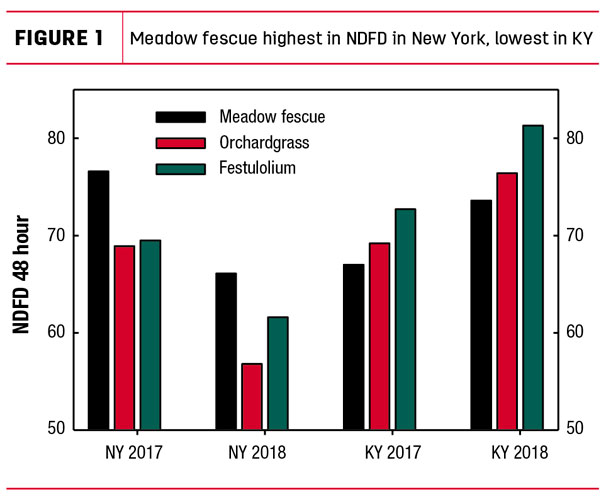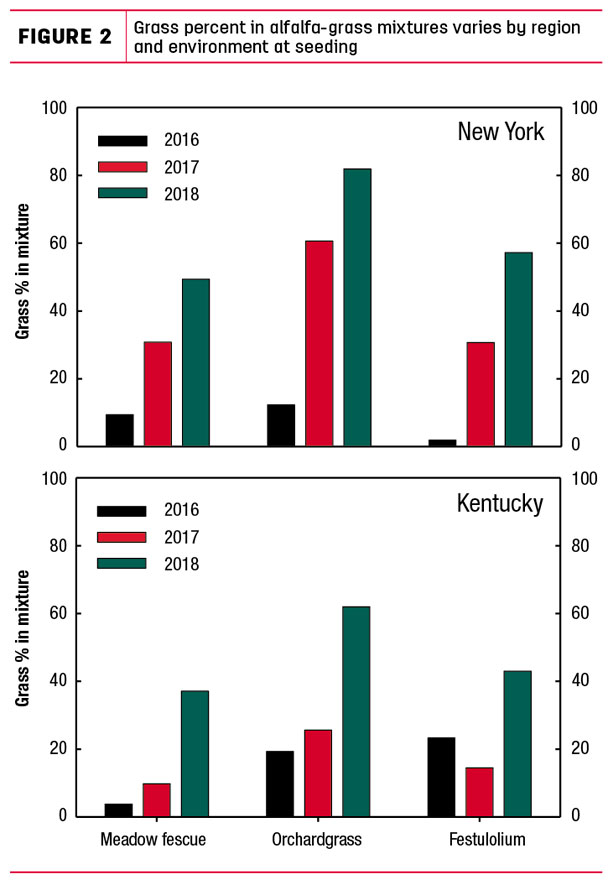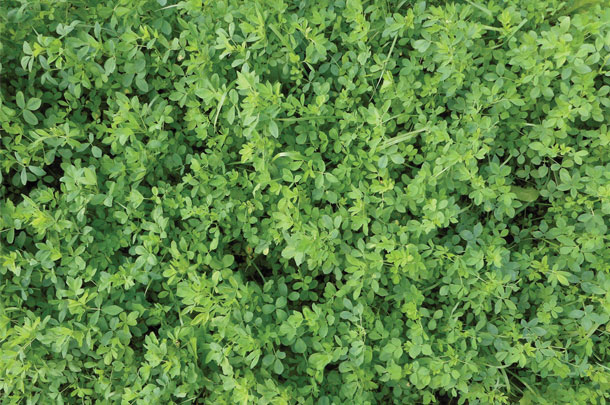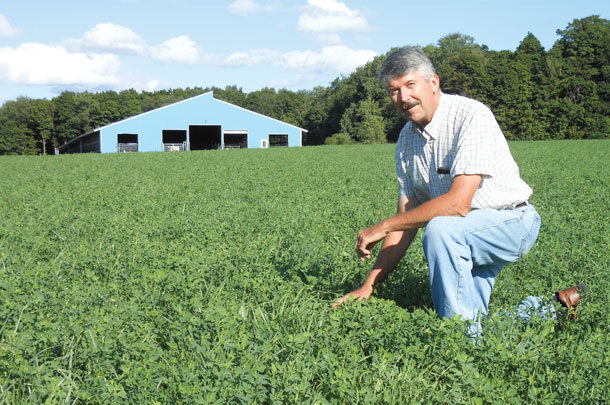The National Institute of Food and Agriculture (NIFA) funded a research project conducted in Kentucky, Minnesota and New York to evaluate high-quality alfalfa and alfalfa-grass mixtures. We are featuring alfalfa-grass results for this article. The three grasses used were Driftless meadow fescue, Dividend VL orchardgrass, and Fojtan festulolium. Stands were spring seeded in 2016, with a full season in 2017 and a spring harvest in 2018. In Kentucky, grasses can have difficulty with spring seedings.
Yield
Alfalfa-grass yields tend to be similar to pure alfalfa in the Midwest, but are often higher than pure alfalfa in the Northeast. In 2017, seasonal dry matter yields for Kentucky and Minnesota averaged 4.6 tons per acre, with no differences among grass species or pure alfalfa stands.
In New York in 2017, alfalfa-orchardgrass yields were 5.4 tons per acre, 16 percent higher than pure alfalfa stands at 4.9 tons per acre. In the spring of 2018, mixtures for all three grasses averaged 16 percent higher yield than pure alfalfa in New York. Perennial grass is ideally suited to much of the Northeast, with moderate temperatures and usually adequate rainfall.
Forage quality
Grasses are normally 20 to 30 percentage units higher in fiber digestibility than alfalfa. As numerous trials in New York have shown, meadow fescue was considerably higher in fiber digestibility than the other grasses in New York (Figure 1). 
Trials in Wisconsin also have shown high fiber digestibility for meadow fescue.
While meadow fescue has been consistently high in quality in the Northeast, results from Kentucky show that meadow fescue was the lowest in fiber digestibility of the grasses. Kentucky may be outside of the ideal environmental range for meadow fescue production.
Grass in the mixture
Grass percentage in mixtures is a function of the grass species, the grass seeding rate and the availability of moisture for the first few weeks after seeding. Even with very low grass percentage in mixtures in the seeding year in the Northeast, grass percentage can increase rapidly (Figure 2).

The figure includes grass percentage at the end of the seeding year (2016), a four-cut average for the first production year (2017) and spring grass percentage in 2018. Orchardgrass in particular is ideally suited to the Northeast and very competitive with alfalfa.
Grass percentage can also be greatly affected by the region of the country. While average grass percentage increased greatly during the first production year in New York, it did not change greatly in Kentucky (Figure 2). Grass percentage in Kentucky did increase greatly from 2017 to 2018, but still was considerably lower than in New York. Orchardgrass percentage in New York was 20 percent higher than Kentucky in 2018.
When is meadow fescue-alfalfa a good idea?
Grass has much higher fiber digestibility than alfalfa. Meadow fescue has considerably higher fiber digestibility than other commonly used grasses in some parts of the country. Wisconsin dairy feeding trials have resulted in similar milk production between alfalfa diets and meadow fescue-alfalfa diets.

Grass in a mixture can increase the harvest window, particularly for regrowth cuttings. Grass with alfalfa will increase the drying rate of cut forage. Mixtures with grass improve soil health with less soil erosion. There are less insect pests and diseases in mixtures, and mixtures typically have longer stand life.
Also, corn silage-alfalfa dairy rations often require additional fiber; grass is considerably higher in neutral detergent fiber (NDF) than alfalfa. Grass in the dairy ration will reduce the level of readily fermentable carbohydrates in the ration. The addition of grass makes for a healthier diet, reducing the occurrence of a variety of animal health issues.
When is meadow fescue-alfalfa a bad idea?
If a buyer wants pure alfalfa hay, it is pointless to try and convince them to switch to alfalfa-grass. According to USDA-NRCS, meadow fescue can be found growing in all states except Hawaii, while other government websites exclude it from the southern U.S. In reality, however, it is a northern species, best suited to Canada and the northern U.S.
While meadow fescue is supposedly less aggressive than tall fescue, it has proven to be very aggressive with alfalfa, at least in the northeastern U.S. A very low seeding rate (1 to 2 pounds per acre) is required to minimize the chances of excess grass in the mixture.
In the late fall of 2017 in New York, unusually warm, wet weather resulted in excessive meadow fescue growth; stands with more than 50 percent grass matted down and, in some cases, smothered alfalfa plants over the winter. This is likely a rare occurrence, however, and one solution would be a post-freeze harvest.
Other challenges with mixtures
Alfalfa growth and development is driven by growing degree days (GDD), while grass development in spring is controlled by day length. Based on Michigan State research, alfalfa averages 35 percent NDF at 600 GDD and 40 percent NDF at about 750 GDD. Abnormally cool spring weather will set back alfalfa development, but not grass.
This can occasionally complicate harvest management for mixed stands. In the spring of 2018 in New York, for example, early-bud stage alfalfa harvested May 30 was only 36 percent NDF (640 GDD), while grass in mixtures was fully headed out and averaged 64 percent NDF. This resulted in the unusually low fiber digestibility for grass in New York for 2018 (Figure 1).
Consider mixtures
Choice of grass species for mixtures will depend on your region of the country. Choice of grass varieties will depend on whether New York local variety trial data is available. Out-of-state grass variety trials will not provide useful information. A high-quality alfalfa variety mixed with a high-quality grass should significantly improve milk production. ![]()
PHOTO 1: Perennial grass grown with alfalfa can provide as much or more yield than pure alfalfa, and mixtures can provide a healthier diet for cows. Pictured: Ken Paddock, forage research assistant. Photo by Seth Paddock.
PHOTO 2: A little meadow fescue in the fall of the seeding year (10 percent grass, September 2018) can become 40 to 50 percent meadow fescue the following spring. Photo by Jerry Cherney.
D.J. Cherney is with the Cornell University Department of Animal Science.
S.R. Smith is with the University of Kentucky Department of Plant and Soil Science.
C.C. Sheaffer is with the University of Minnesota Department of Agronomy and Plant Genetics.
M.S. Wells is with the University of Minnesota Department of Agronomy and Plant Genetics.
J.H. Cherney is with the Cornell University School of Integrative Plant Science.










